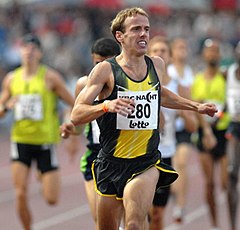Famous Runners with Flat Feet
Nobody would ever argue that their flat feet offered any physical advantage to their fitness regime. Instead, the postural deformity of fallen arches is known to cause an array of uncomfortable complications, including Achilles tendonitis, arthritis, plantar fasciitis, or shin splints.
However, in modern times, flat feet are no longer considered to be the immovable obstacles that they once were, and these troubles are hardly enough to prevent ambitious runners from reaching their full potential. In fact, many of the world’s greatest runners who were seemingly cursed by flat feet still managed to find a way to move faster than anyone else. To celebrate these triumphs, here is a list of three highly impressive flat-footed athletes, who will hopefully motivate you to keep your own arches marching.
Saïd Aouita
Considered one of the first famous Arab sportspeople, Moroccan born Saïd Aouita boasts an extensive list of achievements which left his competitors in the dust. His passion was firmly fixed to the track and field events, and he left his permanent mark on that scene when he won the 5,000 meters at the 1984 Summer Olympics. Saïd’s impressive résumé doesn’t end there either, as he’s set many world records too, including the fastest time for the 1,500 meters (at 3:29.46), 2,000 meters (at 4:50.80), 3,000 meters (at 7:29.45), and twice for the 5,000 meters (at 13:00.40 and 12:58.39). What’s more, these are only a small portion of the man’s complete accomplishments.
Despite attaining such monumental successes, Saïd Aouita admits that his fallen arches have been an issue during his entire career. ”My only problem is that I have flat feet, which promotes tendinitis,” he admitted to French newspaper L’Equipe. Since then, Aouita has credited his special shoes for providing the additional support he needs, which is the same solution that many similar runners have discovered for themselves. Supplementing fallen arches with an orthotic insole can help balance out the pressure on your feet and better support the adjoining ligaments and tendons.
Alan Webb
In 2007, American track and field athlete Alan Webb broke the U.S. Record for the fastest mile time ever, clocking in at 3:46.91. Said record still remains unbeaten to this very day. Alan is also known for his representation of the United States during the 2004 Summer Olympics where he ran the 1,500-meter race. Due to such an impressive biography, it’s no surprise to anyone that Nike hired him to represent their brand from 2002 – 2013.
The irony of this Nike sponsorship is not lost on Christopher McDougall, who is the author of the book Born to Run. According to McDougall, Webb’s fallen arches were a source of constant pain and injuries for the athlete, until he changed his training to include intensive barefoot sessions. Reportedly, this seemingly simple alteration eventually pushed Webb’s feet to actually develop arches, and his shoe size shrank down three sizes as a result!
Haile Gebrselassie
Finally, there’s Haile Gebrselassie, who is often considered the greatest long-distance runner of all time. Born in Ethiopia, Haile earned this revered reputation by conquering an unfathomable amount of achievements, including the two 10,000-meter Olympic gold medals to his name (1996 and 2000), and the Berlin Marathon which he won four times in a row (2006 – 2009). He also set 27 world records over his professional career.
Haile Gebrselassie’s overpronation has long been studied by experts (watch this video for an interesting analysis), while Gebrselassie himself has publicly recognized his postural deformity too. “When I wore shoes, it was difficult,” Haile famously confessed in his early years. His solution? Much like Alan Webb, Haile found barefoot running to be a more comfortable approach, learning to work with his arches rather than succumbing to any so-called disadvantages.
Conclusion
For those who find themselves continuously grappling with flat feet hindrances, then use these athletes as your inspiration to find ways to deal with your problems. There are plenty of options available, including the above insole support and barefoot training sessions. You should also spend some additional time on pre-run calf stretches, focus on losing any excess weight, and speak to your doctor about surgical procedures if you are at your rope’s end.
But above all else, just remember that flat feet are never an excuse to give up on your goals. And if you ever lose faith in your own abilities, simply admire the above athletes to remind yourself of the endless possibilities if you refuse to let anything stand in your way.

I have flat feet and have been always a great sportsman, mainly runner, voleyball, basketball, football (soccer) swimming and cycling performer. I may have not been a pro but i have achieved good quality and enjoyment, and even though suffered from pain some times and problems related to my greek and flat feet, i am very thankful of a good physical education received in Cuba, along with an active lifestyle learned in Africa in my childhood, which I believe was key to be well fit from an early age to endure such a doomed feet configuration.
I am regular visitor, how are you everybody? This article posted at this website is in fact nice.
The irony of this Nike sponsorship is not lost on Christopher McDougall, who is the author of the book Born to Run))))
https://www.intensedebate.com/people/dekspin